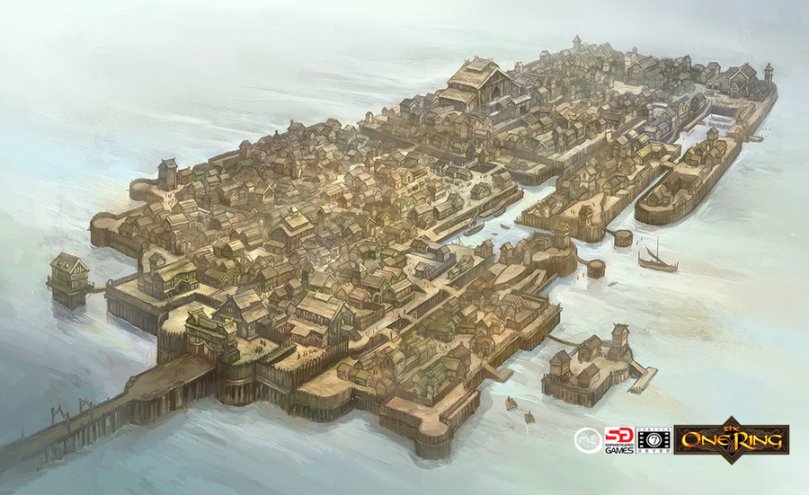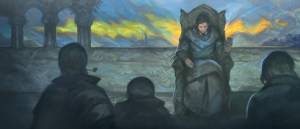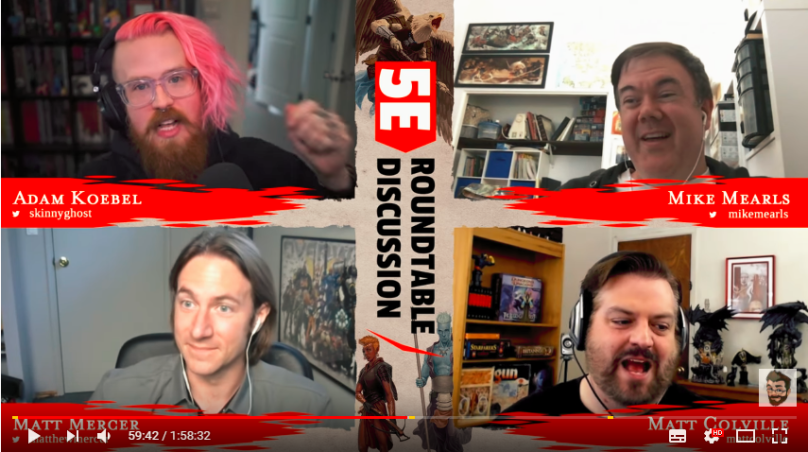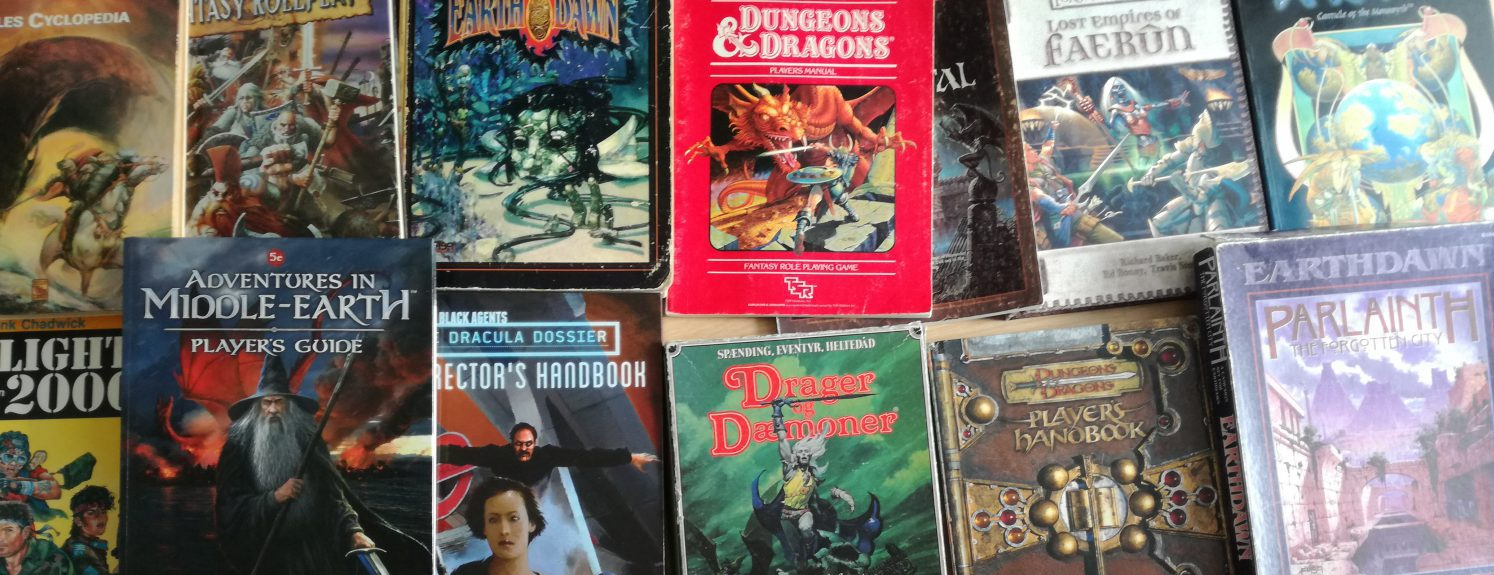I’ve now read the Loremaster’s Guide for Adventures in Middle-Earth by Cubicle 7. In short, I still love the game, and I will run the Wilderland Adventures (see review soon), but unfortunately, the Lore Master’s Guide, isn’t quite at the excellent level of the Player’s Guide (review here).
The Player’s Guide was extremely well done, and I basically had nothing bad to say about it.
The Loremaster’s Guide is also incredibly beautiful in its artwork and layout. It expands on some of the unique mechanics for the game, like Journeys and the Audiences, and it adds wonderous items and legendary weapons and armor with an approach to the D&D rules that I think is great. The magic item section is my favourite section of the book.
But, overall, on the content side it falls a bit short compared to the Player’s Guide.
Fundamentally, I think there are some things missing from the book, and it feels short and ‘light’. It is 50 pages shorter than the Player’s Guide, but has the same price tag. If I had felt they covered everything I needed, that would be fine, but they don’t, so I feel a bit dissappointed.
For a more in-depth view of the book, keep reading. It is a pretty long read.
The book is divided into 9 sections with Setting, Adversaries and Battle taking up about half of the pages.
Setting and the Tale of Years
 The first large section is on the setting. It has a few pages on the Wilderlands and about 10 pages on Lake-town, which is the default starting location for the game. It also has a useful timeline, which has both ancient history and future events included.
The first large section is on the setting. It has a few pages on the Wilderlands and about 10 pages on Lake-town, which is the default starting location for the game. It also has a useful timeline, which has both ancient history and future events included.
It is not a bad section, but the game is called Adventures in Middle-Earth – not Adventures in Wilderland – and as a Loremaster, I would really like to have seen at least a few pages devoted to other lands, such as Gondor and Rohan, particularly since you can play characters coming from these lands. Currently, it is only half a page. Who is Steward in Gondor? Who is king of Rohan? What is their political situation? I expect my players to ask those question. I would have liked help answering them.
Furthermore, I think, despite the fact that you can look these things up on the internet, it would be fitting with a high-level introduction to some of the mythology of Tolkien’s world. I’ve read the Silmarillion, but it is many years ago, and I would have loved a couple of pages on the first and second age. For example, it would have been nice with a brief introduction to the different elves and how they relate to the setting, what the Valar are, the Fall of Núemnor, Angmar and the Witch King and so on.
The map for Laketown is on the inside cover, and it is great, and the guide is solid and useful. The adventure hooks are not very inventive, but that is a minor issue.
Before the Game & the Adventuring Phase
The second section is 2½ pages on things you should talk to your players about before starting the game. I think it is relevant, and certainly something I will do.
Adventures in Middle-Earth is not like playing regular D&D and players may need to adjust their expectations. For example, the theme The Long Defeat in a Fallen World highlights that the players can’t defeat the great evil in the world, they can at best achieve a ‘watchful peace’. There is a melancholic undertone to Tolkien’s world. As a Loremaster you can tone it down, but it important for creating the right ‘feel’ in Middle-Earth. Obviously, this runs counter to many regular D&D campaigns, and should be addressed before the game.
For the Adventuring Phase (the third section) there is the advice that goes for any game master. But you also get some advice on how to play with Tolkien’s setting, which has some good points. One of the points is that the Hobbit is written as a memoir, and thus subjective. Therefore, the events of the novel might have transpired a bit different than Bilbo remembers it. Another perspective is that Tolkien probably didn’t see his own work as having an established ‘canon’, which means you are a Loremaster also have room to add your own story-telling.
On the mechanics side, they grant some extra advice on rest, exhaustion and inspiration. I particularly look forward to seeing how rest plays in the game. It is of great importance, and mechanically much more interesting than in D&D. The guide highlights that it is up to the Loremaster to manage the pressure you apply to the company, and the amount of rest available is key to that.
All in all, the two sections have some needed advice for Loremasters, particularly, if you only have experience running a D&D 5th edition game.
Journeys

The fourth section is only 8 pages, and it discuss journeys, ways to run them, and a couple of pitfalls. It finally adds rules for creating your own Journey Events Tables.
The section includes half a page of ‘Ideas for things seen on the road’, which is a paragraph of random scenery description. This might be relevant for novice Loremasters, but to me it seems like padding. You can almost flip to any page of Lord of the Rings to get something similar.
NPCs and Audiences:
Beyond the introductory general discussion of NPCs, and how people view strangers, this section has a selection of NPC stats and accompanying motivations and expectations that helps you roleplay them. I think the motivations and expectations are a nice addition and I think the NPCs you are most likely to use are covered. The more senior NPCs – like the Dwarf Lord and Elf Lord – I think should have a few more special moves or tricks. They feel a bit underwhelming, basically, but that can easily be fixed.

Audiences is a core part of the game. You can fail an audience, which has consequences and might take the adventure into a new direction, and that creates drama.
These rules dig deeper into the mechanics and how to use audiences in play.
I like how the players must consider, who introduces the group, because which culture he or she comes from influences the audience. And the players can – ideally – figure out, what approach (brash, groveling, chatty etc.) is most likely to result in a successful audience, based on the information they have about the NPC.
Incidentally, this system gets close to what the esteemed round table of Mike Mearls, Matt Colville, Matt Mercer and Adam Koebel discuss, on having a separate framework for interactions, which the Audience mechanic basically is.

Adversaries and Battle
I probably have the most problems with this section. There’s nothing wrong that can’t be fixed or created by a Loremaster, but that takes time.
The best part is the introduction, which describes how battles in Middle-Earth feel. For example, they are often in interesting locations that favor the enemy, they are often defensive and escape is often not an option. To support that, the designers have included some Combat Scenery you can use. The combat scenery is useful. It is a nice list of things that can impact a fight, such as Black toadstools, a Flooded Pit or Web. My critique is the layout. Each type of scenery is listed under an area, such as The Wild, Mirkwood or Ruins. The problem is that every time a type of scenery could occur in an area it is describe again. It means that the mechanics for Bog is described twice, and so is Thicket, Bracken, Nettle Bank and several others. It is a waste of space, in my view. If they had organized it differently, they could have had room for more ideas and perhaps more diverse terrain e.g. Wastelands.

The second part is a Wilderland Bestiary. This section describes 11 types of orcs, a couple of giant spiders, six trolls, a wild wolf and the wolf leader, werewolf, Hound of Sauron and Vampires. It is enough creatures to run a low-level campaign. But I’m disappointed that they only cover creatures from Wilderland, and that the highest Challenge Rating creature is 6. I think when you name a book the Loremaster’s guide to Adventures in Middle-Earth, you need to give the Loremaster the basics to run any campaign in Middle-Earth. In my view, they should have included the classic Tolkien creatures, like the Ent, a Ring Wraith, a Barrow Wight and perhaps even the Balrog (and you could of course argue that all these monsters are in the regular monster manual, but they aren’t covered in the Open Game License).
I also disagree with how the designers set some of the challenge ratings. One aspect is how I see the Middle-Earth world, and the relative strength of the heroes and their adversaries. It is fair that the designers have a different view.
My game master gripe is that the adversaries don’t cover a wide enough spectrum of play, which would have been easy to fix. The trolls are a particularly good example. There are six troll types, and they range from CR 2 to CR 6. The mountain troll is described as incredibly strong and dangerous in the text, so why not make them CR 8 or 9? I would want a group of four 5th level characters to fear encountering one of the stronger trolls. Now, I have to modify it myself.
Furthermore, if you assume that orcs and trolls are the primary foes for an entire adventuring career, you need to widen the scope. What would an encounter for a 13th level group look like? Eight mountain trolls, as written, would get crushed by the players, I think.

Another example, is the legendary Werewolf of Mirkwood. It is CR 6. It is feared all over Mirkwood and the surrounding area. In the Rhovanion Region Guide (which I will write about soon), Beorn is CR 11. Thus, Beorn, would easily defeat the Werewolf. Is that the relative power level that the designers were aiming at? From a Lore Master perspective, the issue is that if this is meant as a monster that hunts alone, CR 6 very quickly becomes a walk-over for the characters.
After the list of monsters the book has six pages of special creature actions and abilities. They are primarily intended to add flavor to the game, and to add surprises in combat.
I think it is a welcome addition, and with less variety of monsters, compared to regular D&D, you need to spice up the orcs, trolls and so on, to keep them interesting. I particularly like some of the very thematic abilities like the troll ability ‘In the Sack with you!’ and ‘Drums’ for the orcs.
Magic Items and Magic
This is not the actual titles of the next two chapters, but that is what they cover. They are also my favourite chapters of the book. It is probably also the only part in the book that is really useful for other D&D games.
The two chapters have a general discussion on magic and treasure in the game. Adventures in Middle-Earth is not a game where you riffle through the pouches of every fallen enemy. The good people of Middle-Earth value beautiful things, but greed and acquiring money for its own sake is not seen a heroic.
Wonderous artefacts are very rare items that confer a blessing to the character. The blessing is normally tied to a skill or ability. Mechanically, they let you add you proficiency bonus to a check, or lets you add it twice, if you are already proficient. But at this point, you are still not doing anything ‘magical’. Your character is simply very good at something. To obtain a ‘Magical Result’, ie. Create an effect that would normally be impossible, like turning invisible, you have to spend hit dice to get the effect. The Lore Master decides how many, depending on the effect.
I think this mechanic is excellent, and something I would use for my regular D&D game. But particularly in Middle-Earth, where the players have little healing available, hit dice are more valuable. Therefore, spending hit dice to gain a magical effect is a more meaningful choice. I love it!
The section on legendary weapons and armor adds items that confer a +2 or +3 bonus to the characters and other combat bonuses. All of these items have names and history, and the higher level you are the more enchanted qualities you can benefit from (up to three). The system reminds me of the dwarven runes from Warhammer Fantasy Roleplay 2nd edition, where an item could have up to three runes. As Cubicle 7 will begin publishing Warhammer Fantasy Roleplay, I assume they are familiar with it…
Magical healing includes the classic Lembas bread and Miruvor drink.
Finally, there is a discussion on how you create your own supernatural forces and creatures, and certain categories that fit well with the setting, such as: Oaths and Curses, Items have Power and Necromancy.
The Fellowship Phase

The last section of the book deals with the fellowship phase. It deals with Sanctuaries and Patrons and adds a couple of undertakings. It has a couple of pages on how to run the fellow-ship phase and what the effects of a Sanctuary are.
I have one gripe with the section, and again it ties in with the length of the book. The section has two paragraphs on Experience Points. And it says: ’While the precise system you chose is up to you, and the topic is beyond the scope of this supplement…’ Wait. What? Awarding experience points is a topic beyond the scope of the Lore Master’s Guide? Where else would you expect to find this information? Awarding experience points is a key aspect of the task of running a game, and I would have expected some advice on XP and player progression, as the game has less monsters and combat compared to regular D&D.
My Final Thoughts on the Loremaster’s Guide
If you have kept with me this far, I’m fairly certain you are interested in Adventures in Middle-Earth. And despite my criticism of this supplement, it is still a useful, well written, well-organized and beautiful book. It is just not as great as the Player’s Guide.
I will have to play the game to truly understand if there are any information that I would need missing from the book.
If you are a future Loremaster of Adventures in Middle-Earth, you should still get this book.


[…] written about Adventures in Middle-Earth on this blog previously (Player’s Guide and Loremaster’s Guide), and been quite excited on their use of the D&D 5th edition rules and their very thematic take […]
LikeLike
[…] Adventures with my group of 7 players. You can also read reviews of other AiME products on this blog. These adventure blog-posts are one part review and one part suggestions for Loremasters on how to […]
LikeLike
[…] Adventures with my group of 7 players. You can also read reviews of other AiME products on this blog. These adventure blog-posts are part review and part suggestions for Loremasters on how to run or […]
LikeLike
[…] Player’s Guide to Adventures in Middle-Earth Loremaster’s Guide to Adventures in Middle-Earth Loremaster’s Screen and Eaves of Mirkwood Mirkwood Campaign Wilderland Adventures Rhovanion […]
LikeLike
This is a nice, accurate review and you touched on all of the key points about how it works and differs from standard 5e.
I am Loremaster for a large circle of 10 D&D players, all of us having played way back in the mid-70’s using the original Gygax booklet rules. We recently reunited with most of us in retirement with free time on our hands. They were particular interested in playing a Middle Earth campaign.
I managed to acquire all of the out-of-print Adventues in Middle Earth guides and supplements, some of it at a clearance price from a local game shop and one guide shipped from a Norfolk UK game shop!
The players still wanted to play standard 5e build characters, so we allowed that and I adjusted the adventures to account for that. So what we play is sort of a hybrid of 5e and AiME, with magic significantly tamped down apart from what is within Tolkien lore.
We started with a journey down the Anduin River, starting from Beorn’s Halls and ending in Minas Tirith, consisting of about 10 missions, some of it taken from the Rhovanian region guide.
The players love the Middle Earth setting and how we’ve integrated the AiME rules into a 5e campaign.
These guides are now nearly impossible to find and if so, priced as collector’s items. A complete set is now worth close to $1000.
LikeLiked by 1 person
Thank you, Cahaya. That is my dream retirement! 😃 I fortunately also have an almost complete collection, but I assume Free League will expand the line further – both for 5e and TOR 2e.
LikeLike